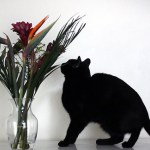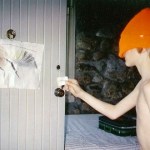Navel-gazing
If you're tired of talking about the debacle that was PepsiCo's paid blog that was sprung on us here at ScienceBlogs earlier this week, please carry on elsewhere.
However, this episode is certainly the talk of both scientists and journalists. I suspect that this case will be discussed and dissected in the coming months at conferences and in journalism classrooms around the world.
Two questions have arisen in the last few days between discussion with my wife and fellow bloggers that have not been answered. One has a true answer while the other is more of a value judgement:
1. PepsiCo's Mehmood…
I would like to point out that when an Australian says "pot plant", they mean house plant. We had some issues with this linguistic distinction when Mrs. Myrmecos first moved here from Melbourne and started telling everyone about the great pot plants we were growing on the porch.
I do congratulate the fine folks at Antweb, though, for having the emotional maturity to let the vocabulary slide and just answer the question.
This shot was taken in the natural ambience of our living room with the soft light of a rainy dusk filtering through the windows. I coaxed Mingus the Cat to the top of the bookshelf with some treats and waited for him to check out the boquet.
Owing to the lack of light I used a fast lens (Canon's 35mm f2.0 prime) open to f2.0 at ISO 1600.
A: If, at birthday parties, the featured game is "pin-the-stinger-on-the-bee."
your intrepid blogger, circa 1985
You may thank my mother for sending along this, um, interesting photo.
From the "I-never-thought-I'd-use-this-class" file, I took a semester course once from an oil spill expert. Professor Ed Gilfillan had studied the response of Prince William Sound to various clean-up regimens following the wreck of the Exxon Valdez, and we spent weeks learning about chemistry of oil spills and the factors involved in ecological recovery. The class was over 15 years ago, mind you, and in retrospect I remember only two things.
But these are two very key things, and they are both relevant to the ongoing tragedy in the Gulf of Mexico.
1. The soil structure at the coastline will…
Blog posts are long, thin things.
One could, for example, use a blog to post a high-resolution map of Chile. Or a single strand of spagetti. Any image up to 500 pixels wide, for as long as it goes. In that vein, here's a Cephalotes varians turtle ant:
Just wait until I find a stick insect.
Earlier, while noting greater rates of pseudonymous blogging by women, Morgan Jackson raised the topic of why the majority of tenure-track science positions go to men. It's a striking pattern, especially considering that at the graduate student level women predominate in many fields- including entomology.
The obvious culprit is that women face discrimination in hiring decisions, as several of our commentators mention. And make no mistake- that does happen.
But I've seen enough people drop out of science to realize that there's more than just individual gender-based discrimination at work.…
What happens if you score bug blogs for various characters and crunch them through a phylogenetic analysis?
Morgan Jackson investigates:
Although Morgan's exercise was tongue-in-cheek, he did uncover a pattern worthy of further exploration:
The last thing I want to comment on is the huge skew between male and female insect bloggers. Of the 58 blogs where I could determine the author's sex, only 28% of them were written solely by women. Even more concerning perhaps is that 38% of these women bloggers choose to remain anonymous, while not a single male blogger chose to stay private! With…
I've often remarked that the beauty of this blog is that more people read here every day than I would reach in even the largest class I teach. Moreover, far more people read this blog than will ever read my peer-reviewed scientific publications. And that's even considering that we have very modest traffic numbers here for ScienceBlogs.com. Of course, Terra Sig readers are very discriminating - and good-looking, erudite, and probably even smell good, too.
This morning, my Twitter feed brought me a post from the blog, University of Venus, as referred to me by HASTAC Director of New Media…
Although this paper is several years old, I still read through it for a good laugh now and again. It's a bold attempt by Aussie myrmecologist Alan Andersen to remedy the dearth of ant common names. Hilarity ensues.
Snugglepot Ant?
As we know, ants are too small and too numerous for most species to have caught the attention of the broader human populace. Few species have ever acquired a vernacular name, in any language, and biologists are generally happy to use the formal Latin nomenclature.
Genial Killer Ants?
Andersen's hallucinogenic trip through the myrmecofauna is worth a read,…
I apologize for the slow blogging. I've been under the weather this weekend, and what energy I could muster went to more pressing things. Like patching an unfortunate hole in the kitchen wall from when the doorstop failed.
I also had some minor paperwork. I am being contracted to work remotely for a University in another state, and they sent along a question about what I've done "to foster multicultural understanding and cultural competence?"
While penning the obligatory bland response about international research and my old Peace Corps days, it occurred to me that many scientists who have to…
What's this?
Five points for picking the family, five points for the genus. And infinity points for figuring out what the those balloon-like structures are for. I have no idea.
...at the scope.
Photo details: Tamron SP 11-18mm 4.5 on a Canon EOS 50D
ISO 800, f4.5, 1/50 sec
Termite mounds visible in Australia's Northern Territory- I've circled three, but dozens are in the image.
Central Illinois still resembles the frozen lifeless tundra, so to get my bug-hunting fix I've been surfing about on Google Earth. Here at -13.066783, 130.847383 I've found something: Australia's magnificent magnetic termites. The green things are trees, but the little black pimply bits? Those are the termites. On the ground they look like this:
A magnetic termite mound in north Queensland, Australia.
Why "magnetic"?
The mounds are shaped as thin blades along a north-…
If I were to mention an ant-fungus mutualism- that is, an ecological partnership between an ant and a fungus that benefits both- most biologically literate people might think of the famed leafcutter ants and the edible mycelia they cultivate. But that is just one example.
Several other fungi have entered into productive relationships with ants, assisting especially in ant architecture. Consider:
Lasius umbratus walking in the galleries of an underground carton nest (Illinois)
A larger view of the same nest. The intricate galleries are made from fungal mycelia growing…
Feeling nostalgic this afternoon for my Peace Corps days, I did a Google Earth fly-by of my adoptive community, Colónia Once de Setiembre. Not only does Google show the site in high-resolution, the images are clear enough to see a patch of trees I planted with my neighbor in 1997. Judging from the shadows, our token attempt at reforestation must be at least 10 meters tall now.
The miracle of the internet also allows me to confirm that the economy of Once de Setiembre hasn't changed much since I left.
Here's an issue that's been on my mind as I'm shuffling trees around from several concurrent phylogenetic projects.
The primary output from phylogenetics programs is tree diagrams depicting the relationships among organisms. Very clean, very crisp, very precise diagrams. Precision isn't in itself a problem, but for the human foible of mistaking precision for accuracy.
I'm not interested in a precise estimate of evolutionary history so much as a correct one. I'm reminded as much when I see my estimates change from one precise conclusion to another as I add more data from…
Do any of you know what this little animal might be? I honestly have no idea, and rather than look it up I thought I'd crowd-source it to you folks first.
It was lurking on the underside of a leaf at the Archbold Biological Station in Florida along the shores of a sinkhole lake. This was back in June. It's about a centimeter long.
update: It's a hover fly larva. Ted MacRae picked it- thanks!
Myrmecos Blog appeared online two years ago today.  While I'm obviously the guy writing most of the posts, the reason we're still on the air isn't me and my bloviating. It is all of you guys- the readers, the guest bloggers, the commentators. Without the life provided to the site by the many participants, I'd long since have lost the incentive to keep at it. So, a heartfelt thank you.
If I had to finger any one difference between blogging in 2007 and blogging in 2009, it is this. In 2007 blogs had already risen to mainstream acceptability, especially in the…
Now stop playing around on the internet and go spend some time with your friends and family.



